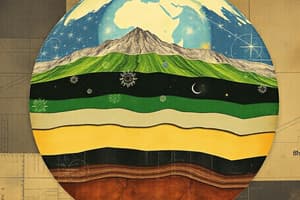Podcast
Questions and Answers
What geological phenomena are primarily associated with convergent boundaries?
What geological phenomena are primarily associated with convergent boundaries?
- Formation of new crust
- Formation of mountain ranges (correct)
- Creation of volcanic activity (correct)
- Movement of plates horizontally
What happens at transform boundaries?
What happens at transform boundaries?
- Mountains are formed
- New crust is created
- Plates slide past each other (correct)
- Plates collide and one is subducted
Which of the following statements about divergent boundaries is correct?
Which of the following statements about divergent boundaries is correct?
- They involve horizontal movement between plates
- They occur when two plates compress against each other
- They result in the destruction of crust
- They are characterized by plates moving away from each other (correct)
What is the main characteristic of transform boundaries?
What is the main characteristic of transform boundaries?
What is the result of the collision of two continental plates at convergent boundaries?
What is the result of the collision of two continental plates at convergent boundaries?
What is the external layer of the Earth known as?
What is the external layer of the Earth known as?
Which layer of the Earth is the thickest?
Which layer of the Earth is the thickest?
How thick is the oceanic crust on average?
How thick is the oceanic crust on average?
Which layer of the mantle is semi-fluid and allows the movement of tectonic plates?
Which layer of the mantle is semi-fluid and allows the movement of tectonic plates?
What is the average thickness of the continental crust?
What is the average thickness of the continental crust?
The Earth's core is primarily composed of which type of material?
The Earth's core is primarily composed of which type of material?
What distinguishes the outer core from the inner core?
What distinguishes the outer core from the inner core?
What is a key characteristic of the Earth's crust?
What is a key characteristic of the Earth's crust?
What is the primary composition of the outer core?
What is the primary composition of the outer core?
How thick is the Earth's crust approximately?
How thick is the Earth's crust approximately?
What layer of the Earth is located beneath the crust?
What layer of the Earth is located beneath the crust?
What occurs at divergent boundaries?
What occurs at divergent boundaries?
What is the radius of the inner core approximately?
What is the radius of the inner core approximately?
What type of boundary occurs when tectonic plates collide?
What type of boundary occurs when tectonic plates collide?
What characteristic feature is formed at divergent boundaries on land?
What characteristic feature is formed at divergent boundaries on land?
Which layer of the Earth is considered to be the thickest?
Which layer of the Earth is considered to be the thickest?
Flashcards are hidden until you start studying
Study Notes
Earth's Geosphere
- The Geosphere is the solid part of Earth, including rocks, minerals, landforms, and the processes shaping them.
- It is divided into three primary layers: the crust, the mantle, and the core.
Earth's Layers
- Crust: The outermost layer, ranging from 5 to 70 kilometers thick.
- Continental Crust: Thicker, found under continents, about 35 kilometers on average
- Oceanic Crust: Thinner, found under ocean basins, about 7 kilometers on average
- Mantle: The thickest layer, extending from the crust's base to 2,900 kilometers deep.
- Upper Mantle: Relatively rigid, contains asthenosphere (semi-fluid layer enabling tectonic plate movement)
- Lower Mantle: Solid, contributes to convection and heat transfer within Earth.
- Core: The innermost layer, beneath the mantle.
- Outer Core: Liquid layer primarily composed of molten iron and nickel, 2,300 kilometers thick.
- Inner Core: Solid core, primarily composed of solid iron and nickel, with a radius of 1,220 kilometers.
Earth's Tectonic Plates
- Earth's crust is divided into massive pieces called tectonic plates.
- These plates float on the semi-fluid mantle below them.
- There are three types of interactions between these plates:
- Divergent Boundaries: Plates move apart, creating new crust as magma rises from the mantle.
- On land, creates rift valleys.
- Convergent Boundaries: Plates collide, resulting in various geological phenomena.
- When continental plates collide, mountains form due to compression and folding
- Transform Boundaries: Plates slide horizontally past each other.
- Causes earthquakes due to friction between plates.
- Divergent Boundaries: Plates move apart, creating new crust as magma rises from the mantle.
Studying That Suits You
Use AI to generate personalized quizzes and flashcards to suit your learning preferences.



